Paul Hindemith
Paul Hindemith (/ˈpaʊlˈhɪndəmɪt/, powl HIN-deh-mitt; 16 November 1895 – 28 December 1963) was a German and American composer, music theorist, teacher, violist and conductor. He founded the Amar Quartet in 1921, touring extensively in Europe. As a composer, he became a major advocate of the Neue Sachlichkeit (New Objectivity) style of music in the 1920s, with compositions such as Kammermusik, including works with viola and viola d'amore as solo instruments in a neo-Bachian spirit. Other notable compositions include his song cycle Das Marienleben (1923), Der Schwanendreher for viola and orchestra (1935), the opera Mathis der Maler (1938), the Symphonic Metamorphosis of Themes by Carl Maria von Weber (1943), and the oratorio When Lilacs Last in the Dooryard Bloom'd (1946), a requiem based on Walt Whitman's poem. Hindemith and his wife emigrated to Switzerland and the United States ahead of World War II, after worsening difficulties with the Nazi German regime. In his later years, he conducted and recorded much of his own music.
Paul Hindemith | |
|---|---|
 Hindemith in 1923 | |
| Born | 16 November 1895 |
| Died | 28 December 1963 (aged 68) |
| Education | Dr. Hoch's Konservatorium |
| Occupations |
|
| Organizations | |
| Works | Compositions |
| Awards | |
Most of Hindemith's compositions are anchored by a foundational tone, and use musical forms and counterpoint and cadences typical of the Baroque and Classical traditions. His harmonic language is more modern, freely using all 12 notes of the chromatic scale within his tonal framework, as detailed in his three-volume treatise, The Craft of Musical Composition.
Life and career
Paul Hindemith was born in Hanau, near Frankfurt, the eldest child of the painter and decorator Robert Hindemith from Lower Silesia and his wife Marie Hindemith, née Warnecke.[1] He was taught the violin as a child. He entered Frankfurt's Dr. Hoch's Konservatorium, where he studied violin with Adolf Rebner, as well as conducting and composition with Arnold Mendelssohn and Bernhard Sekles. At first he supported himself by playing in dance bands and musical-comedy groups. He became deputy leader of the Frankfurt Opera Orchestra in 1914 and was promoted to concertmaster in 1916.[2] He played second violin in the Rebner String Quartet from 1914.
After his father's 1915 death in World War I, Hindemith was conscripted into the Imperial German Army in September 1917 and sent to a regiment in Alsace in January 1918.[3] There he was assigned to play bass drum in the regiment band, and also formed a string quartet. In May 1918 he was deployed to the front in Flanders, where he served as a sentry; his diary has him "surviving grenade attacks only by good luck", according to New Grove Dictionary.[3] After the armistice he returned to Frankfurt and the Rebner Quartet.[3]
In 1921, Hindemith founded the Amar Quartet, playing viola, and extensively toured Europe with an emphasis on contemporary music. His younger brother Rudolf was the original cellist.[4]
As a composer, he became a major advocate of the Neue Sachlichkeit (New Objectivity) style of music in the 1920s, with compositions such as Kammermusik. Reminiscent of Bach's Brandenburg Concertos, they include works with viola and viola d'amore as solo instruments in a neo-Bachian spirit.[5] In 1922, some of his pieces were played in the International Society for Contemporary Music festival at Salzburg, which first brought him to the attention of an international audience. The next year, he composed the song cycle Das Marienleben (The Life of Mary) and began to work as an organizer of the Donaueschingen Festival, where he programmed works by several avant-garde composers, including Anton Webern and Arnold Schoenberg. In 1927 he was appointed Professor at the Berliner Hochschule für Musik in Berlin.[6] Hindemith wrote the music for Hans Richter's 1928 avant-garde film Ghosts Before Breakfast (Vormittagsspuk) and also acted in the film; the score and original film were later burned by the Nazis.[7] In 1929, Hindemith played the solo part in the premiere of William Walton's viola concerto, after Lionel Tertis, for whom it was written, turned it down.
On 15 May 1924, Hindemith married the actress and singer Gertrud (Johanna Gertrude) Rottenberg (1900–1967).[1] The marriage was childless.[8]
The Nazis' relationship to Hindemith's music was complicated. Some condemned his music as "degenerate" (largely based on his early, sexually charged operas such as Sancta Susanna). In December 1934, during a speech at the Berlin Sports Palace, Germany's Minister of Propaganda Joseph Goebbels publicly denounced Hindemith as an "atonal noisemaker".[9] The Nazis banned his music in October 1936, and he was subsequently included in the 1938 Entartete Musik (Degenerate Music) exhibition in Düsseldorf.[10] Other officials working in Nazi Germany, though, thought that he might provide Germany with an example of a modern German composer, as, by this time, he was writing music based in tonality, with frequent references to folk music. The conductor Wilhelm Furtwängler's defence of Hindemith, published in 1934, takes this line.[11] The controversy around his work continued throughout the thirties, with Hindemith falling in and out of favour with the Nazis.
During the 1930s, Hindemith visited Cairo and also Ankara several times. He accepted an invitation from the Turkish government to oversee the creation of a music school in Ankara in 1935, after Goebbels had pressured him to request an indefinite leave of absence from the Berlin Academy.[10] In Turkey, he was the leading figure of a new music pedagogy in the era of president Kemal Atatürk. His deputy was Eduard Zuckmayer. Hindemith led the reorganization of Turkish music education and the early efforts to establish the Turkish State Opera and Ballet. He did not stay in Turkey as long as many other émigrés, but he greatly influenced Turkish musical life; the Ankara State Conservatory owes much to his efforts. Young Turkish musicians regarded Hindemith as a "real master", and he was appreciated and greatly respected.[9]
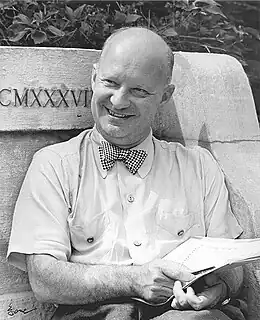
Toward the end of the 1930s, Hindemith made several tours of America as a viola and viola d'amore soloist.
He emigrated to Switzerland in 1938, partly because his wife was of part-Jewish ancestry.[12]
At the same time that he was codifying his musical language, Hindemith's teaching and compositions began to be affected by his theories, according to critics such as Ernest Ansermet.[13] Arriving in the U.S. in 1940, he taught primarily at Yale University,[14] where he founded the Yale Collegium Musicum.[5] He had such notable students as Lukas Foss, Graham George, Andrew Hill, Norman Dello Joio, Mel Powell, Yehudi Wyner, Harold Shapero, Hans Otte, Ruth Schönthal, Samuel Adler, Leonard Sarason, Fenno Heath, Tony-winning composer Mitch Leigh, and Oscar-winning film director George Roy Hill. Hindemith also taught at the University at Buffalo, Cornell University, and Wells College.[15] During this time he gave the Charles Eliot Norton Lectures at Harvard, from which the book A Composer's World (1952) was extracted.[16] Hindemith had a long friendship with Erich Katz, whose compositions were influenced by him.[17] Also among Hindemith's students were the future rocket scientist Wernher von Braun[18] and the composers Franz Reizenstein, Harald Genzmer, Oskar Sala, Arnold Cooke,[19] Robert Strassburg,[20] and dozens of other notables.
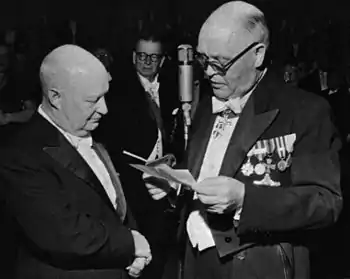
Hindemith became a U.S. citizen in 1946, but returned to Europe in 1953, living in Zürich and teaching at the university there until he retired from teaching in 1957.[5][10] Toward the end of his life he began to conduct more and made numerous recordings, mostly of his own music.[10]
In 1954, an anonymous critic for Opera magazine, having attended a performance of Hindemith's Neues vom Tage, wrote: "Mr Hindemith is no virtuoso conductor, but he does possess an extraordinary knack of making performers understand how his own music is supposed to go."[21]
Hindemith received the Wihuri Sibelius Prize in 1955.[22] He was awarded the Balzan Prize in 1962 "for the wealth, extent and variety of his work, which is among the most valid in contemporary music, and which contains masterpieces of opera, symphonic and chamber music."[22][23]
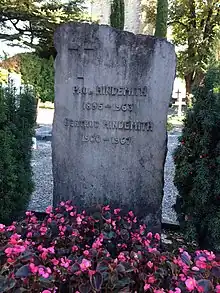
Despite a prolonged decline in his physical health, Hindemith composed almost until his death. He died in Frankfurt from pancreatitis, aged 68. He and his wife are buried in Cimetière La Chiésaz, La Chiésaz, Canton of Vaud, Switzerland.[1]
Music
Hindemith is among the most significant German composers of his time. His early works are in a late romantic idiom, and he later produced expressionist works, rather in the style of the early Schoenberg, before developing a leaner, contrapuntally complex style in the 1920s. This style has been described as neoclassical,[24] but is quite different from the works by Igor Stravinsky labeled with that term, owing more to the contrapuntal language of Johann Sebastian Bach and Max Reger than the Classical clarity of Mozart.
The new style can be heard in the series of works called Kammermusik (Chamber Music) from 1922 to 1927. Each of these pieces is written for a different small instrumental ensemble, many of them very unusual. Kammermusik No. 6, for example, is a concerto for the viola d'amore, an instrument that has not been in wide use since the baroque period, but which Hindemith himself played. He continued to write for unusual groups of instruments throughout his life, producing (for example) a trio for viola, heckelphone and piano (1928), seven trios for three trautoniums (1930), a sonata for double bass, and a concerto for trumpet, bassoon, and strings (both in 1949).
In the 1930s Hindemith began to write less for chamber music groups, and more for large orchestral forces. He wrote his opera Mathis der Maler, based on the life of the painter Matthias Grünewald, in 1933–1935. This opera is rarely staged, though a well-known production by the New York City Opera in 1995 was an exception.[25] It combines the neo-classicism of earlier works with folk song. As a preliminary stage to the composing of this opera, Hindemith wrote a purely instrumental symphony also called Mathis der Maler, which is one of his most frequently performed works. In the opera, some portions of the symphony appear as instrumental interludes; others were elaborated in vocal scenes.
Hindemith wrote Gebrauchsmusik (Music for Use)—compositions intended to have a social or political purpose and sometimes written to be played by amateurs. The concept was inspired by Bertolt Brecht. An example of this is Hindemith's Trauermusik (Funeral Music), written in January 1936. He was preparing the London premiere of his viola concerto Der Schwanendreher when he heard news of the death of George V. He quickly wrote Trauermusik for solo viola and string orchestra in tribute to the late king, and the premiere was given that same evening, the day after the king's death.[26] Other examples of Hindemith's Gebrauchsmusik include:
- the Plöner Musiktage (1932), a series of pieces written for a day of community music-making in the city of Plön, culminating in an evening concert by grammar-school students and teachers.
- a Scherzo for viola and cello (1934), written in several hours during a series of recording sessions as a "filler" for an unexpected blank side of a 78 rpm album, and recorded immediately upon its completion.
- Wir bauen eine Stadt ("We're Building a City"), an opera for eight-year-olds (1930).
Hindemith's most popular work, both on record and in the concert hall, is probably the Symphonic Metamorphosis of Themes by Carl Maria von Weber, written in 1943. It takes melodies from various works by Carl Maria von Weber, mainly piano duets, but also one from the overture to his incidental music for Turandot (Op. 37/J. 75), and transforms and adapts them so that each movement of the piece is based on one theme.
In 1951, Hindemith completed his Symphony in B-flat. Scored for concert band, it was written for the U.S. Army Band "Pershing's Own". Hindemith premiered it with that band on 5 April of that year.[27] Its second performance took place under the baton of Hugh McMillan, conducting the Boulder Symphonic Band at the University of Colorado. The piece is representative of Hindemith's late works, exhibiting strong contrapuntal lines throughout, and is a cornerstone of the band repertoire. He recorded it in stereo with members of the Philharmonia Orchestra for EMI in 1956.
Musical system
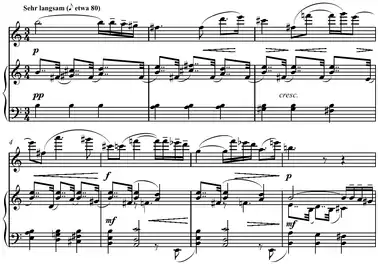
Most of Hindemith's music employs a unique system that is tonal but non-diatonic, often notated without a traditional key signature. Like most tonal music, it is centred on a tonic and modulates from one tonal centre to another, but it "attempts ... the free use of all the twelve tones of the chromatic scale",[28] rather than relying on a diatonic scale as a restricted subset of these notes. He even rewrote some of his music after developing this system. One of the core features of Hindemith's system is a ranking of all musical intervals of the 12-tone equally tempered scale, from the most consonant to the most dissonant. He classifies chords in six categories, on the basis of dissonance, whether they contain a tritone, and whether they clearly suggest a root or tonal centre. His philosophy also encompassed melody—he strove for melodies that do not clearly outline major or minor triads.[29]
In the late 1930s Hindemith wrote an instructional treatise in three volumes, The Craft of Musical Composition, which lays out this system in great detail. He also advocated this system as a means of understanding and analyzing the harmonic structure of other music, claiming that it has a broader reach than the traditional Roman numeral approach to chords (an approach strongly tied to diatonic scales). In the final chapter of Book 1, Hindemith seeks to illustrate the wide-ranging relevance and applicability of his system, analyzing musical examples from the medieval to the contemporary. These analyses include the early Gregorian melody Dies irae, compositions by Guillaume de Machaut, J. S. Bach, Richard Wagner, Igor Stravinsky, Arnold Schoenberg, and a composition of his own.[30]
Hindemith's 1942 piano work Ludus Tonalis contains twelve fugues, in the manner of Johann Sebastian Bach, using traditional devices like inversion, diminution, augmentation, retrogradation, stretto, etc. Each fugue is connected by an interlude to the next, during which the music moves from the key of the last to its successor. The order of the keys follows Hindemith's ranking of musical intervals around the tonal center of C.[31]
Another traditional aspect of classical music that Hindemith retains is the idea of dissonance resolving to consonance. Much of Hindemith's music begins in consonant territory, progresses into dissonant tension, and resolves in full, consonant chords and cadences.[32] This is especially apparent in his Concert Music for Strings and Brass (1930).
Awards and honors
.jpg.webp)
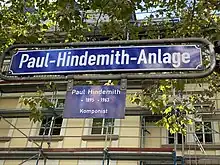
- Howland Memorial Prize (1940), awarded by Yale University[1][33]
- Elected to American Academy of Arts and Sciences (1940)[34]
- Bach Prize of the Free and Hanseatic City of Hamburg (1951)[1][35]
- Order Pour le Mérite (1952)[35][36]
- Wihuri Sibelius Prize (1955)[1][35]
- Goethe Plaque of the City of Frankfurt (1955)[37]
- Elected to the American Philosophical Society (1962)[38]
- Balzan Prize (1963)[1][35]
- 5157 Hindemith (1973), asteroid discovered and named for him[39]
Honorary doctorates
- Philadelphia Academy of Music (1945)[33]
- Columbia University (1948)[33]
- Goethe University Frankfurt (1949)[1][35]
- FU Berlin (1950)[1][35]
- Oxford University (1954)[1][35]
Compositions
Pedagogical writings
Hindemith's complete set of instructional books, in possible educational order:
- Elementary Training for Musicians. London: Schott; New York: Associated Music Publishers, 1946. ISBN 978-0-901938-16-9
- A Concentrated Course in Traditional Harmony
- Book 1: Theoretical Part, translated by Arthur Mendel. London: Schott; New York: Associated Music Publishers, 1942. ISBN 978-0-901938-30-5
- Book 2: Exercises in Two-Part Writing, translated by Otto Ortmann. London: Schott; New York: Associated Music Publishers, 1941. ISBN 978-0-901938-41-1
- Book 3: Übungsbuch für den dreistimmigen Satz [Exercises in Three-Part Writing]. Mainz: Schott, 1970. Only available in the original German. ISBN 978-3-7957-1605-9
Notable students
Recordings
Hindemith was a prolific composer.[40] He conducted some of his own music in a series of recordings for EMI with the Philharmonia Orchestra and for Deutsche Grammophon with the Berlin Philharmonic Orchestra, which have been digitally remastered and released on CD.[41][42] The Violin Concerto was also recorded by Decca/London, with the composer conducting the London Symphony Orchestra and David Oistrakh as soloist. Everest Records issued a recording of Hindemith's postwar When Lilacs Last in the Dooryard Bloom'd ("A Requiem for Those We Love") on LP, conducted by Hindemith. A stereo recording of Hindemith conducting the requiem with the New York Philharmonic Orchestra, with Louise Parker and George London as soloists, was made for Columbia Records in 1963 and later issued on CD. He also appeared on television as a guest conductor of the Chicago Symphony Orchestra's nationally syndicated "Music from Chicago" series; the performances have been released by VAI on home video. A complete collection of Hindemith's orchestral music was recorded by German and Australian orchestras, all conducted by Werner Andreas Albert and released on the CPO label.
Hindemithon Festival
An annual festival of Hindemith's music has been held at William Paterson University in Wayne, New Jersey, from 2003 through at least 2017. It features student, staff, and professional musicians performing a range of Hindemith's works.[43]
See also
References
Notes
- Maurer Zenck, Claudia (2018). "Paul Hindemith". In Maurer Zenck, Claudia; Petersen, Peter; Fetthauer, Sophie (eds.). Lexikon verfolgter Musiker und Musikerinnen der NS-Zeit. Hamburg: Universität Hamburg. Retrieved 8 August 2020.
- Mootz, William (19 February 1950). "Hindemith To Conduct Sinfonietta Here Next Week". The Courier-Journal. Louisville, KY. p. 69. Retrieved 24 May 2020 – via Newspapers.com.
- Schubert, Giselher (2001). "Hindemith, Paul". Grove Music Online. Oxford: Oxford University Press. doi:10.1093/gmo/9781561592630.article.13053. ISBN 978-1-56159-263-0. (subscription or UK public library membership required)
- Potter, Tully (2003). Hindemith as Interpreter: The Amar-Hindemith Quartet (Liner notes). Arbiter Records. 139. Retrieved 7 April 2023.
- "Paul Hindemith — People — Royal Opera House". www.roh.org.uk. Retrieved 22 August 2018.
- A Dictionary of Twentieth Century World Biography. United Kingdom: Book Club Associates, 1992, p. 267.
- Wilke, Tobias (2010). Medien der Unmittelbarkeit (in German). Munich: Wilhelm Fink. p. 63. ISBN 978-3-7705-4923-8.
- "Marriage: Paul Hindemith". www.hindemith.info.
- Reisman, Arnold, ed. (2006). "Chapter 5: The Creators". Turkey's Modernization: Refugees from Nazism and Atatürk's Vision. New Academia Publishing. pp. 88–90. ISBN 978-0-9777908-8-3. Retrieved 5 April 2023.
- "Music and the Holocaust: Paul Hindemith". holocaustmusic.ort.org. ORT. Retrieved 22 August 2018.
- Furtwängler 1934.
- Steinberg, Michael (1998). The Concerto: A Listener's Guide. Oxford University Press. p. 205. ISBN 978-0-19-802634-1. Retrieved 23 March 2013.
- Ansermet 1961, note to p. 42 added on an errata slip.
- "Yale Plans to honor Composer Paul Hindemith". The Bridgeport Post. Bridgeport, CT. 25 October 1964. p. 46. Retrieved 24 May 2020 – via Newspapers.com.
- "Courses as an Instructor: Paul Hindemith". www.hindemith.info.
- Hindemith, Paul (1952). A Composer's World: Horizons and Limitations. Cambridge: Harvard University Press.
- Davenport 1970, p. 43.
- Ward, Bob (2005). Dr. Space: The Life of Wernher von Braun. Naval Institute Press. p. 11. ISBN 978-1-591-14926-2.
- Lessing, Kolja (2002). Notes to Franz Reizenstein: Solo Sonatas. EDA Records.
- Pfitzinger, Scott (2017). Composer Genealogies: A Compendium of Composers, Their Teachers, and Their Students. Rowman & Littlefield. p. 522. ISBN 978-1-4422-7225-5 – via Google Books.
- Opera (June 1954): 348.
- "Paul Hindemith, modern music pioneer, succumbs at age 68". Intelligencer Journal. Lancaster, Pennsylvania. 30 December 1963. p. 9. Retrieved 24 May 2020 – via Newspapers.com.
- "Paul Hindemith: 1962 Balzan Prize for Music". Retrieved 22 August 2018.
- Taylor 1997, p. 261.
- Holland 1995.
- Steinberg, Michael (1998). The Concerto: A Listener's Guide. Oxford University Press. p. 212. ISBN 978-0-19-802634-1. Retrieved 23 March 2013.
- "Biography". Hindemith Foundation. Archived from the original on 13 April 2001.
- Searle, Humphrey (1955). Twentieth Century Counterpoint (2nd ed.). London: Ernest Benn. p. 55.
- "Principles and Categories". www.hindemith.info. Hindemith Foundation. Retrieved 30 March 2023.
- Hindemith, Paul. Unterweisung im Tonsatz. 3 vols. Mainz: B. Schott's Söhne, 1937–1970. First two volumes in English, as The Craft of Musical Composition, translated by Arthur Mendel and Otto Ortmann. New York: Associated Music Publishers; London: Schott & Co., 1941–1942.
- Tippett, Michael (1995). Tippett on Music, p.77. Oxford University. ISBN 9780198165422.
- Kemp, Ian (1970). Hindemith. Oxford Studies of Composers 6. London: Oxford University Press. p. 19. ISBN 0193141183.
- "Influence in America". www.hindemith.info.
- "Paul Hindemith". American Academy of Arts & Sciences. Retrieved 16 November 2022.
- "Schott Music". en.schott-music.com.
- "Pour le Mérite: Paul Hindemith" (PDF). www.orden-pourlemerite.de. Retrieved 7 August 2020.
- "Hessian Biography". www.lagis-hessen.de.
- "APS Member History". American Philosophical Society. Retrieved 30 March 2023.
- "(5157) Hindemith". IAU Minor Planet Center. Retrieved 5 April 2023.
- Allison, John (4 December 2013). "Paul Hindemith: The 20th century's most neglected composer". The Telegraph. Archived from the original on 12 January 2022.
- "Review: Hindemith Conducts Hindemith". Gramophone: 40. 20 April 1987.
- "Hindemith Conducts Hindemith: The Complete Recordings on Deutsche Grammophon". Amazon. Retrieved 7 October 2012.
- "Midday Artists Series". William Paterson University. Spring 2017. Retrieved 1 April 2023.
Sources
- Ansermet, Ernest. 1961. Les fondements de la musique dans la conscience humaine. 2 v. Neuchâtel: La Baconnière.
- Briner, Andres. 1971. Paul Hindemith. Zürich: Atlantis-Verlag; Mainz: Schott.
- Davenport, LaNoue. 1970. "Erich Katz: A Profile". The American Recorder (Spring): 43–44. Retrieved 2 November 2011.
- Eaglefield-Hull, Arthur (ed.). 1924. A Dictionary of Modern Music and Musicians. London: Dent.
- Furtwängler, Wilhelm. 1934. "Der Fall Hindemith". Deutsche Allgemeine Zeitung 73, no. 551 (Sunday, 25 November): 1. Reprinted in Berta Geissmar, Musik im Schatten der Politik. Zürich: Atlantis, 1945. Reprinted in Wilhelm Furtwängler, Ton und Wort: Aufsätze und Vorträge 1918 bis 1954, 91–96. Wiesbaden: F.A. Brockhaus, 1954; reissued Zürich: Atlantis Musikbuch-Verlag, 1994. ISBN 978-3-254-00199-3. English version as "The Hindemith Case", in Wilhelm Furtwängler, Furtwängler on Music, edited and translated by Ronald Taylor, 117–20. Aldershot, Hants.: Scolar Press, 1991. ISBN 978-0-85967-816-2.
- Hindemith, Paul. 1937–1970. Unterweisung im Tonsatz. 3 vols. Mainz: B. Schott's Söhne. First two volumes in English, as The Craft of Musical Composition, translated by Arthur Mendel and Otto Ortmann. New York: Associated Music Publishers; London: Schott & Co., 1941–1942.
- Hindemith, Paul. 1952. A Composer's World: Horizons and Limitations. Cambridge: Harvard University Press.
- Holland, Bernard. 1995. "Music Review; City Opera Gamely Flirts with Danger". The New York Times, 9 September.
- Kater, Michael H. 1997. The Twisted Muse: Musicians and Their Music in the Third Reich. New York and Oxford: Oxford University Press.
- Kater, Michael H. 2000. Composers of the Nazi Era: Eight Portraits. New York and Oxford: Oxford University Press.
- Kemp, Ian. 1970. Hindemith. Oxford Studies of Composers 6. London, New York: Oxford University Press.
- Neumeyer, David. 1986. The Music of Paul Hindemith. New Haven: Yale University Press.
- Noss, Luther. 1989. Paul Hindemith in the United States. Urbana: University of Illinois Press.
- Preussner, Eberhard. 1984. Paul Hindemith: ein Lebensbild. Innsbruck: Edition Helbling.
- Skelton, Geoffrey. 1975. Paul Hindemith: The Man Behind the Music: A Biography. London: Gollancz.
- Taylor, Ronald. 1997. Berlin and Its Culture: A Historical Portrait. Yale University Press. ISBN 978-0-300-07200-6.
- Taylor-Jay, Claire. 2004. The Artist-Operas of Pfitzner, Krenek and Hindemith: Politics and the Ideology of the Artist. Aldershot: Ashgate.
Further reading
- Fried, Alexander (19 February 1939). "Paul Hindemith Brings Fresh Air to Symphony". The San Francisco Examiner. San Francisco. p. 50. Retrieved 24 May 2020 – via Newspapers.com.
- Schwarze, Richard (21 November 1981). "Hindemith: He was simply a musician who produced 'music as a tree bears fruit' ... Well, not really". The Journal Herald. Dayton, Ohio. p. 27. Retrieved 23 May 2020 – via Newspapers.com.
- Desbruslais, Simon. 2019. The Music and Music Theory of Paul Hindemith. Woodbridge: Boydell Press. ISBN 978-1-78327-210-5.
- Luttmann, Stephen. 2013. Paul Hindemith: A Research and Information Guide. New York: Routledge. ISBN 978-1-135-84841-5.
- Winkler, Heinz-Jürgen (2004). "Fascinated by Early Music: Paul Hindemith and Emanuel Winternitz". Music in Art: International Journal for Music Iconography. 29 (1–2): 14–19. ISSN 1522-7464.
- Petropoulos, Jonathan. 2014. Artists Under Hitler: Collaboration and Survival in Nazi Germany. New Haven and London: Yale University Press. Ch. 5, pp. 88–113, is titled "Paul Hindemith".
External links
- Paul Hindemith Oral History collection at Oral History of American Music
- Free scores by Paul Hindemith on IMSLP at the International Music Score Library Project (IMSLP)
- Hindemith Foundation
- Schott Music Publisher page
- An Inner Emigration, notes on Hindemith and Der Schwanendreher by Ron Drummond
- Paul Hindemith in conversation with Seymour Raven (7 April 1963)
- Publications by and about Paul Hindemith in the catalogue Helveticat of the Swiss National Library
- Newspaper clippings about Paul Hindemith in the 20th Century Press Archives of the ZBW
- "Hindemith Kabinett im Kuhhirtenturm". Museumsufer Frankfurt. Retrieved 21 December 2022.